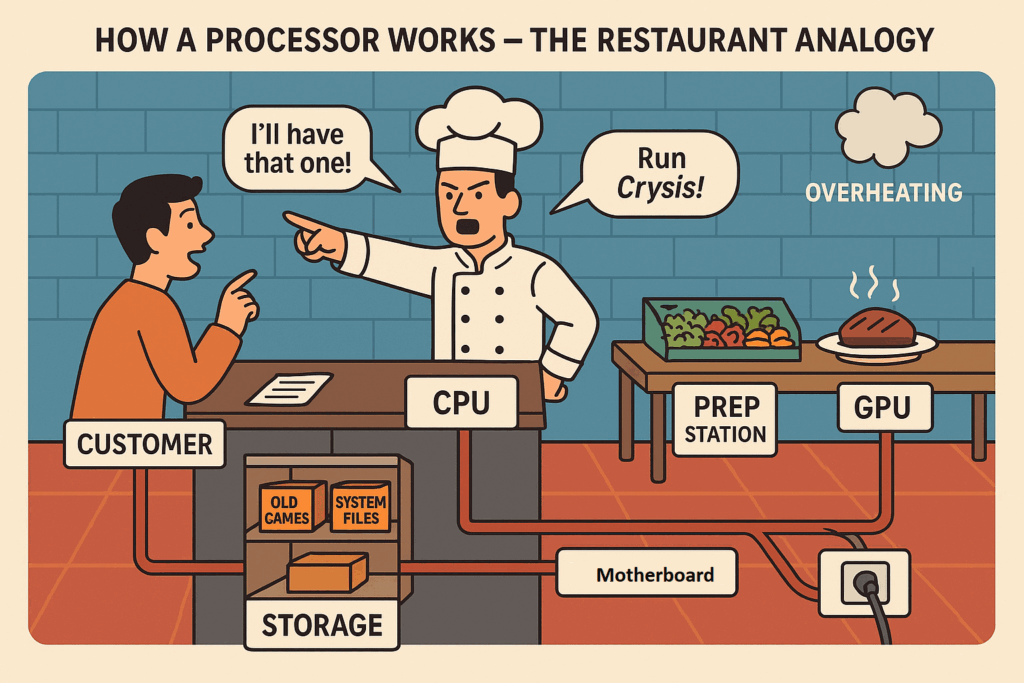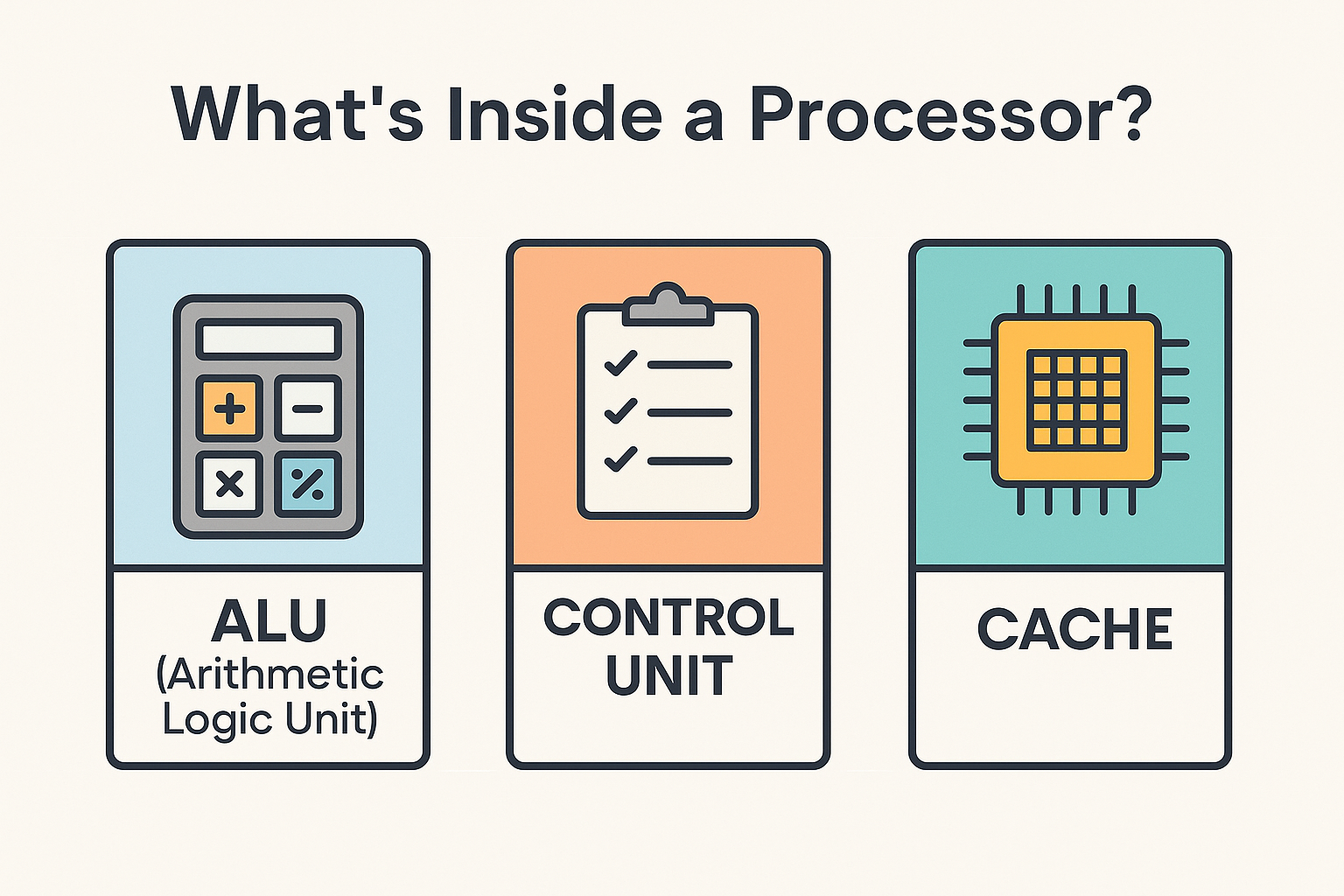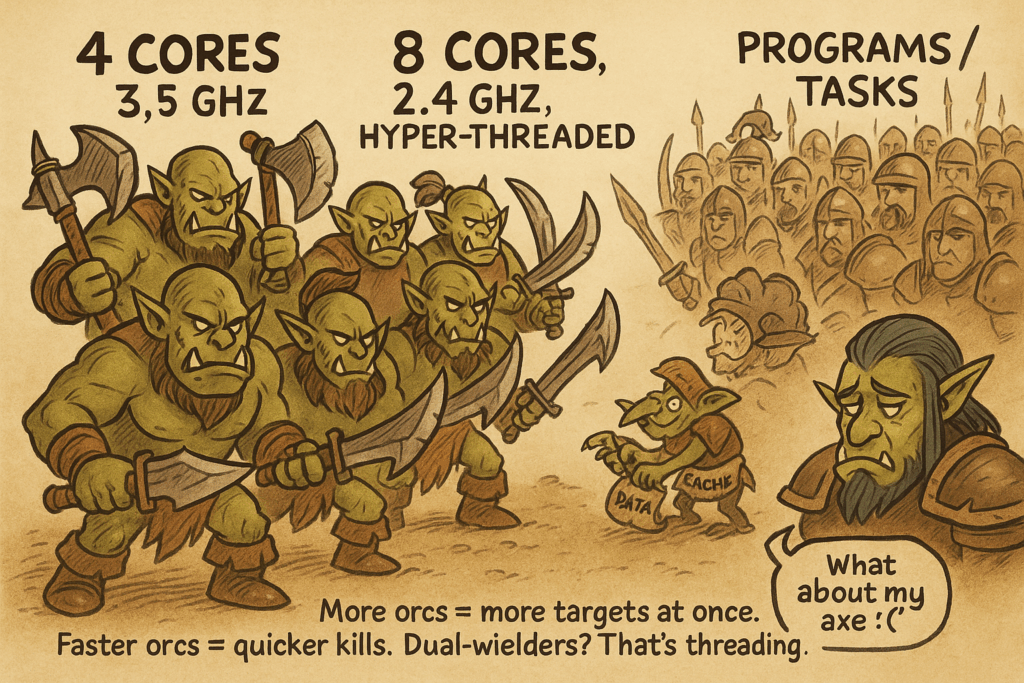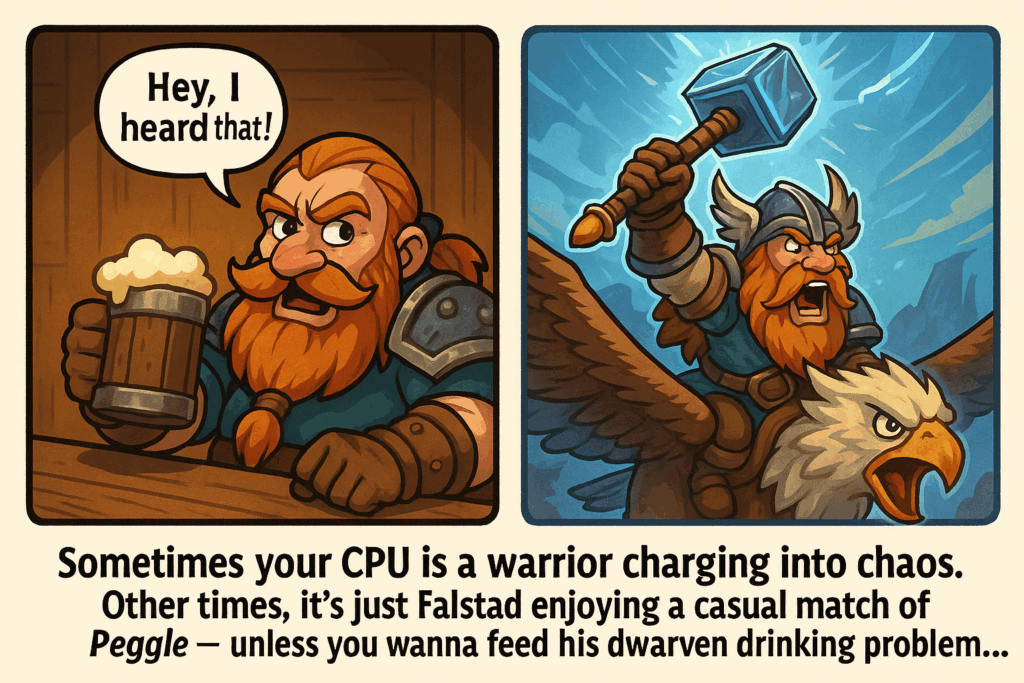Ever wondered what’s actually going on inside that little square chip you trust to load your games, run your tabs, and freeze right when you’re about to clutch a win? Yeah, me too. The processor (or CPU, for the fancy folk) is basically the brain of your PC, except it doesn’t get tired, complain, or suddenly ask to update itself at 2AM… unless you’re using Windows, in which case, all bets are off.
In this post, I’m breaking down how a processor actually works, minus the jargon and with just enough nerdy flavour to keep it interesting. Whether you’re upgrading your rig, building your first PC, or just curious why your laptop sounds like it’s about to take flight, this’ll give you the lowdown in plain English.
Let’s lift the hood and figure out what’s happening inside that brain box we all depend on.Section 1:
Section 1: What Is a Processor (Really?)
The processor, or CPU (Central Processing Unit) if you want to impress your mates, is basically the boss of your computer. It doesn’t do everything itself, but it tells everything else what to do. Kind of like a manager who doesn’t lift anything but somehow still gets all the credit.
Every time you click something, load a program, or boot up a game, the processor steps in like, “Right lads, let’s move,” and starts dishing out instructions to the rest of your components. It handles calculations, logic, and decision-making, fast. Blink, and its done.
Think of it like this: If your PC was a pub, the processor is the barkeep, taking orders, calling the shots, and making sure nobody’s double-tapping the jukebox.

Your CPU is the head chef, barking orders, keeping everything in sync. If it’s under powered, expect cold meals, slow service, and occasional kitchen fires.
Section 2: What’s Inside a Processor?
1. ALU (Arithmetic Logic Unit)
This is the part of the processor that does the actual number crunching. It handles basic math, like adding, subtracting, comparing values, and working out logic decisions. It’s simple but fast, like a kitchen assistant who only knows how to chop, stir, or yell “yes chef!” but can do it ten million times a second.
Analogy: Think of the ALU like a kitchen intern with lightning hands, not glamorous, but without them, nothing gets prepped.
2. Control Unit
The bossy one. It tells the rest of the CPU what to do, when to do it, and in what order. Like a tiny internal manager with a clipboard and a passive-aggressive tone.
Analogy: The control unit is the floor manager pacing around the kitchen yelling, “Chop faster, Kevin!”
3. Cache
This is high-speed memory built into the processor. It keeps the most frequently used data right next to the action, so the CPU doesn’t have to keep running back to RAM like it forgot something in the other room.
Analogy: The spice rack next to the chef, instant access to the essentials, no time wasted.

Section 3: How Instructions Are Processed (The CPU Cycle)
So how does the processor actually do anything? It follows a predictable rhythm — a kind of behind-the-scenes dance move called the Fetch–Decode–Execute cycle.
No, it’s not a Destiny raid mechanic, although it does run just as fast and gets upset when you don’t cool it properly.
1. Fetch
The CPU grabs the next instruction from memory (usually RAM). It’s like a waiter grabbing the next order ticket from the pass, fast, routine, and nonstop.
2. Decode
The control unit steps in and figures out what the instruction actually means. Like translating “I want the special” into: “Grill the steak, hold the onions, extra sauce.”
3. Execute
Now the CPU gets to work — carrying out the instruction it just decoded. That might mean doing some quick math, moving data between parts of your system, or triggering something to appear on your screen. This is the action phase, where clicks become commands and results happen.
Result? Boom – you just opened up 12 Chrome tabs you’ll never read.
By now, we’ve established your CPU is a chef, fast, in charge, and doing a million things at once. But here’s the thing:
Even the best chef burns out if there’s only one of them cooking for an entire stadium.
That’s where clock speed, cores, and threads come in, it’s how your CPU stays sharp, scales up, and avoids melting down when you open Discord, Chrome, Steam, and Spotify all at once like a maniac.
Section 4: Clock Speed, Cores & Threads
Or: Why Your Head Chef Needs Clones and Caffeine
Why Your Head Chef Needs Clones and Caffeine
By now, you know the CPU is your system’s head chef, but even the best chef needs backup when the restaurant’s packed and someone just ordered a triple-decker RGB gaming session with extra tabs on the side.
Let’s break down what makes a CPU fast, and why more doesn’t always mean better (unless we’re talking about garlic bread).
Clock Speed (GHz)
This is how fast each core runs, measured in gigahertz, or “how many instructions per second” it can handle.
3.5GHz = 3.5 billion cycles per second.
Analogy: It’s how fast your chef is chopping. Higher clock = faster single tasks. But speed without help can still bottleneck.
Cores
Cores are like extra chefs. A single-core CPU is one overworked cook. A quad-core? That’s a squad. Modern CPUs come with 4, 6, 8, or even 16 cores, and they can each handle a separate task at the same time.
Analogy: More chefs = more meals being prepped simultaneously. Gaming, streaming, Discord, all at once? You’ll need a full kitchen staff.
Threads
Threads are like giving each chef two more arms, they’re still one person, but now they can multitask a bit better. Most modern CPUs are multi-threaded (like AMD’s SMT or Intel’s Hyper-Threading).
Analogy: It’s not another chef, but it’s a chef doing double duty, flipping a pancake while stirring soup.
Quick Note
Gamers often ask, “Should I get more cores or higher clock speed?”
Short answer: For most games, faster cores > more cores, but newer titles do use more cores effectively, especially if you’re multitasking or streaming.

Section 5: Why It Matters for Gaming (And When It Doesn’t)
By now, you’ve got the full lowdown on how a processor works from head chefs to orc squads to cache goblins. But here’s the real question: what’s the actual takeaway? Is your gameplay going to collapse into a slideshow if you’ve got the wrong CPU? Or is it all just silicon sorcery for hardware nerds?
Here’s the truth: CPU specs matter, but not always. Like anything in PC gaming, it depends on what you’re playing and how you’re using your machine.
When CPU Power Actually Counts
If you’re into high-FPS shooters like CS:GO, Valorant, or Fortnite, then your processor is doing serious heavy lifting. You’ll want strong single-core performance and a decent clock speed, or else your frames will start jittering like a scared NPC. Doesn’t matter how beefy your GPU is if your CPU’s slacking, the bottleneck will be real.
The same goes for massive open-world games like Cyberpunk 2077 or Starfield. These aren’t just about pretty graphics, they’re tracking tons of AI, background physics, and sandbox chaos. In that kind of world, your CPU is doing as much work as your graphics card, maybe more. More cores = more in-game brainpower.
Streaming or multitasking? Different beast entirely. Gaming while running OBS, Discord, Spotify, and twenty Chrome tabs? Yeah… you’ll want those extra cores and threads. Otherwise, expect lag, stutters, and a mental breakdown mid-stream.
When It Doesn’t Really Matter
On the flip side, if you’re running indie games, retro titles, or emulators your CPU is barely breaking a sweat. Most of those games could run on a toaster with a decent fan and a bit of encouragement.
Also: some games are just GPU-bound. That means your graphics card is doing most of the work, while the CPU’s in the back playing cards. Upgrading your CPU in those cases? You won’t notice much difference.
⚔️ One Last Myth to Slay:
“More cores means faster gaming!”
Sounds logical, right? But nah. If the game only uses four cores, the other twelve are just sitting around drinking ale for Falstad consistency, but honestly, it works either way. They might help with background tasks, but your game isn’t using them.
The bottom line?
Buy smart. Build balanced.
You don’t need the newest 16-core monster chip unless your needs (or your ego) demand it. For most gamers, a solid mid-range processor with decent speed and six to eight cores will crush it.
Unless you’re trying to play Crysis in 2025. In that case… may the chef gods be with you.

Conclusion
Processors might be small, but they run the show. Whether you’re charging into battle with a high-core beast or just browsing Steam while Discord hums in the background, your CPU quietly keeps it all together.
When it comes to gaming, the right processor depends on your setup and style. Hardcore streamer juggling OBS, Chrome, and Elden Ring mods? You’ll need more muscle. Casual player with a backlog of indie gems? A mid-range chip will do just fine.
Bottom line: build for balance, not just bragging rights.
And if you ever catch Falstad shouting at you from a tavern about CPU bottlenecks… it’s probably time to upgrade. Or close a few tabs.
More From Gameplay Techy
If you made it this far, congrats, your brain just outperformed half the bots on the internet. Keep the momentum going:
Intel CPU Guide – blue-team brains, architecture smarts, and which chips actually matter.
How Does a GPU Work? – Meet the visual engine that turns code into chaos.
Ryzen CPU Guide – Red-team performance, overclocking, and pure value.







